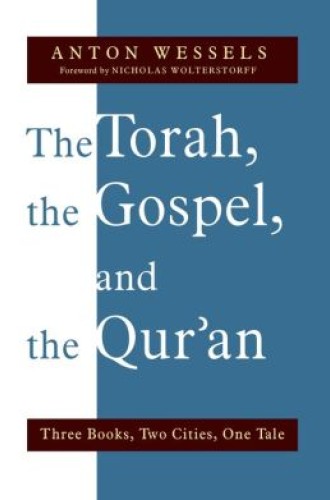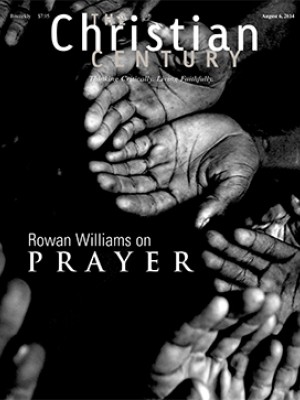The Torah, the Gospel, and the Qur’an, by Anton Wessels
In this daring and wide-ranging work, Anton Wessels interprets the scriptures of the Abrahamic religions as presenting a single narrative common to a united Judeo-Christian-Islamic tradition. A Presbyterian minister and professor emeritus at the Free University in Amsterdam, Wessels is well aware that many people view the Jewish, Christian, and Islamic traditions as hostile competitors, destined forever to mutual animosity, and that others group Judaism and Christianity on one side of a divide as the Judeo-Christian tradition and view Islam in hostile isolation on the other side. Wessels has long been involved in interreligious reflection and has published a wide array of studies ranging from a guide to the Qur’an to a study of the spiritual message of the paintings of Vincent van Gogh to a provocative historical reflection on whether Europe was ever really Christian.
In interreligious studies, investigators may focus primarily on areas of convergence among religious traditions or primarily on areas of divergence. Each approach offers distinctive opportunities and challenges. Aware of how often each of the Abrahamic traditions has interpreted its scripture against the other traditions, Wessels resolutely emphasizes points of convergence, going so far as to assimilate the perspectives of the Torah, the Gospel, and the Qur’an into a single story. It is an audacious wager, and not without dangers.
Read our latest issue or browse back issues.
About midway through his exposition, Wessels summarizes his approach: “My starting point in this book is to read the three Books, the Torah, the Gospel, and the Qur’an, as a single tale: breaking with the city of injustice (Assur, Babel, Sodom) and heading for the city of justice and peace (Jerusalem, Medina).” The frame for Wessels’s tale is the theme of two cities in Augustine’s classic The City of God against the Pagans, with echoes of Charles Dickens’s classic A Tale of Two Cities. Wessels’s entire book could be read as an attempt to update Augustine’s work in light of Islam, incorporating the Qur’an into the story and in the process radically revising many of Augustine’s assumptions.
In setting up his tale, Wessels notes many instances of opposing cities and peoples, such as Jerusalem and Babylon, Sparta and Troy, Athens and the Persians, Rome and Carthage, Mecca and Medina. But the fundamental struggle running throughout is that between pride, or hubris, and submission to God. Each ruler, and indeed each human, faces the choice of whether to be a king, asserting prideful domination over others, or a caliph, accepting God’s reign and exercising authority only as a vice-regent of God. Kings build cities of injustice and exploitation; caliphs build cities where justice and peace may flourish. Nemesis haunts the path of the kings, while the grace of God guides the way of caliphs.
Wessels hopes that a common reading of their scriptures could lead Jews, Christians, and Muslims to celebrate the Exodus together. He recalls a Christian liturgical service in which he welcomed a Jewish colleague to receive the eucharistic cup, though he modified the phrasing, referring not to the “the blood of Christ” but to “the cup of thanksgiving.”
He interprets the apocalyptic texts of all three Abrahamic traditions as unmasking the dynamic of contemporary history; the “land of Magog,” for example, refers to areas of life dominated by the devil, which Wessels identifies as today’s “world trade and world power.” He sees Moloch as “the military industrial complex,” which requires Mammon in order to function. Moloch (power) and Mammon (money) assault believers: “all who build and keep the earth, those who observe the Torah, who are true representatives of God on earth, caliphs, and who do not bring destruction and shed blood on earth.” The beloved city that is under attack is variously named Jerusalem or Medina or “the camp of the saints.”
Wessels passes over numerous questions of biblical interpretation, including many of the complex issues relating to the Jewish and Christian Bibles and to the variety of biblical canons among Christian communities. For the most part Wessels does not devote attention to historical and literary criticism of the Bible or the Qur’an. Rather, he retells portions of the biblical narratives, interweaving corresponding references from the Qur’an. The Qur’an usually does not retell the biblical narratives but rather assumes familiarity with biblical figures and brings them into its own paradigm.
Since his approach is irenic, Wessels downplays the points of difference, recalling that the Qur’an sees all prophets as teaching the same message. In contrast to most Muslims, he interprets the Qur’an’s statements about the end of Jesus’ earthly life in a way that would allow for his death by crucifixion.
Because Islam is the most recent of the traditions, the intertwining often leaves an Islamic stamp on Wessels’s presentation of the tale. Jesus largely appears in Islamic terms as a prophet, albeit one who was crucified, without much attention being paid to the traditional high christological claims that were decisive for Augustine’s understanding of the two cities.
In interreligious dialogue, Muslims respect and honor Jesus and the prophets of ancient Israel, and they frequently invite Jews and Christians to recognize Muhammad as a prophet. Wessels notes that Jews and Christians generally decline the invitation, and he cautions that Muslims generally consider a Jew or Christian who accepts Muhammad as a prophet to have become a Muslim. Nonetheless, he argues that “there is a third way that recognizes Muhammad’s status as prophet but does not require one to become a Muslim in the sociological sense by joining the Muslim umma in the formal sense of the word.” Wessels seeks to integrate the Qur’an’s comments on biblical figures into a Christian understanding of the Bible, but he does not explore the different meanings of the term prophet in the respective traditions.
At times this approach is problematic, as when Wessels identifies the Gospel of Jesus Christ with Injil, the Arabic name used by Muslims for the message that Jesus received. According to the Islamic tradition, Injil refers to a verbal revelation that Jesus reportedly received from God. Muslims believe that the New Testament contains parts of this revelation, but it also contains additions and falsifications that have led Christians to view Jesus as the Son of God.
For Christian readers not conversant with the Qur’an, Wessels offers much helpful information; familiar biblical themes appear in a different light in the Islamic tradition. Wessels offers a strong challenge to all too widely held assumptions of implacable opposition, but his attempt to harmonize the traditions into one tale threatens to erode the distinctive identity of each.






